The ultimate crudité platter (vegetable platter) is packed with fresh vibrant seasonal raw vegetables. Accompanied by a dipping sauce or three, and some crunchy breadsticks or crackers.
Easy entertaining for a dinner party, holiday celebrations, or your next cocktail party.

A large serving tray laden with seasonal veggies, and some small bowls of your favorite dips is the best way to entertain.
A vegetable crudité platter is a great alternative to a cheese platter or charcuterie board. Or for variety serve one alongside them or with a seafood platter.
This is a step-by-step guide on which fresh vegetables to use. What items to make yourself, and what to pick up from the grocery store to make life easier.
Plus the easy way to plate everything up so the board looks stunning.
Why not make a beautiful crudités platter for your next party?
Sara xxx
What's in this post
Types of Vegetables to Use
Fresh veggies are a must, and I suggest a trip to your local farmers market to pick out what's in season. Farmers' markets are known for their seasonal vegetables, and you may also find some unusual or heirloom varieties.
- Green Beans: Long green beans that have been topped but not tailed. Blanch them to bring out their green colour, and slightly tenderise them while keeping some crunch.
- Cherry Tomatoes: I love to cut them in half and then thread them on a small skewer (or toothpick) with cherry bocconcini.
- Baby Carrots/Dutch Carrots: Remove stalks and leaves if still attached, leaving a little green for show, and carefully peel. I find that they can look dried out and unappetising if not peeled.
- Zucchini Blossoms: These edible flowers make a lovely addition.
- Celery Sticks: Remove as much of the celery string as you can.
- Sugar Snap Peas: Simply wash them well and remove the string that runs down one side. I don't blanch them, they are great as they are.
- Baby Corn: Wash well removing any cornsilk. Cut larger corn in half, leave the smaller ones whole.
- Baby Cucumbers: Also known as Qukes (baby Lebanese cucumbers), cut them in halves or quarters.
- Raddish: Wash well leaving their tails intact and some of the green stem. Cut large ones into halves or quarters, and leave any little ones whole.
- Asparagus: Like the beans, quickly give asparagus a blanch.
No matter what you choose make sure they are crisp veggies with a range of beautiful colours. There is nothing more offputting than boring, limp, and lifeless produce.

Dips and Dressings
A great choice of delicious dips is a must, and an obvious choice is to go for something creamy. Don't shy away from bold flavours, but do provide a variety of tastes and textures.
Pictured are beetroot dip, garlic dip, and my everything bagel dip.
- Baba Ghanoush, Garlic Dip, and Hummus work well together for a Middle Eastern feel.
- Ranch Dressing (or tub of ranch dip) with Honey Mustard Dressing for a combination of sweet and tangy.
- Homemade Mayonnaise with some lemon.
- Make your own Trader Joe's Everything Bagel Dip (made with cream cheese, sour cream, and bagel seasoning) for something completely different.
What to Make and What to Buy
Making a crudité platter should be an easy task. By being clever and knowing what to buy and what to make ensures it is not only easy but delicious too.
What to Buy
Buy the vegetables obviously, unless you are pulling them out of the garden. Add any crackers, breadsticks, or cheeses you will be serving to the grocery list too. Good quality dips or dressings are also worth buying.
Buying cheese is obvious, but there is no need to make crackers from scratch. Unless you really want to.
What to Make
An interesting dip or dressing that can't easily be substituted with store-bought is worth making. Most dips and dressings do taste better homemade in any case.
NEVER use store-bought mayo on a crudité platter. Make it from scratch, ready-made vs homemade are like chalk and cheese in taste.
How to Make a Crudité Platter
Scroll to the bottom of the page for a printable recipe card.
I'm going to let you into a little secret. I'm walking you through how to plate a crudité platter the same way I teach my photography students to assemble one to photograph.
Therefore you know it is going to be picture perfect as well as delicious.

Step 1
Choose your serving platter or boards. As you can see from the above I have chosen two wooden boards.
I've placed the smaller board on top of the larger one. This will create height and a little interest.
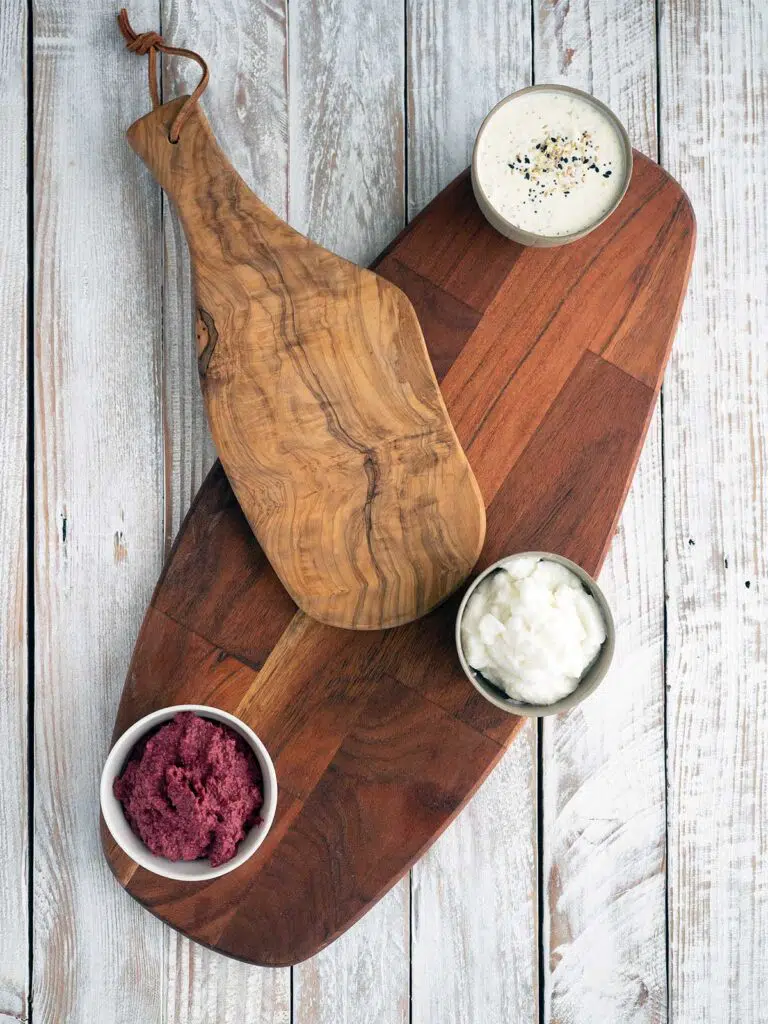
Step 2
Place any bowls of dip or dressing on the board. Space them out, and visually go for an odd number. You can always have more bowls of dip to the side of the main platter.
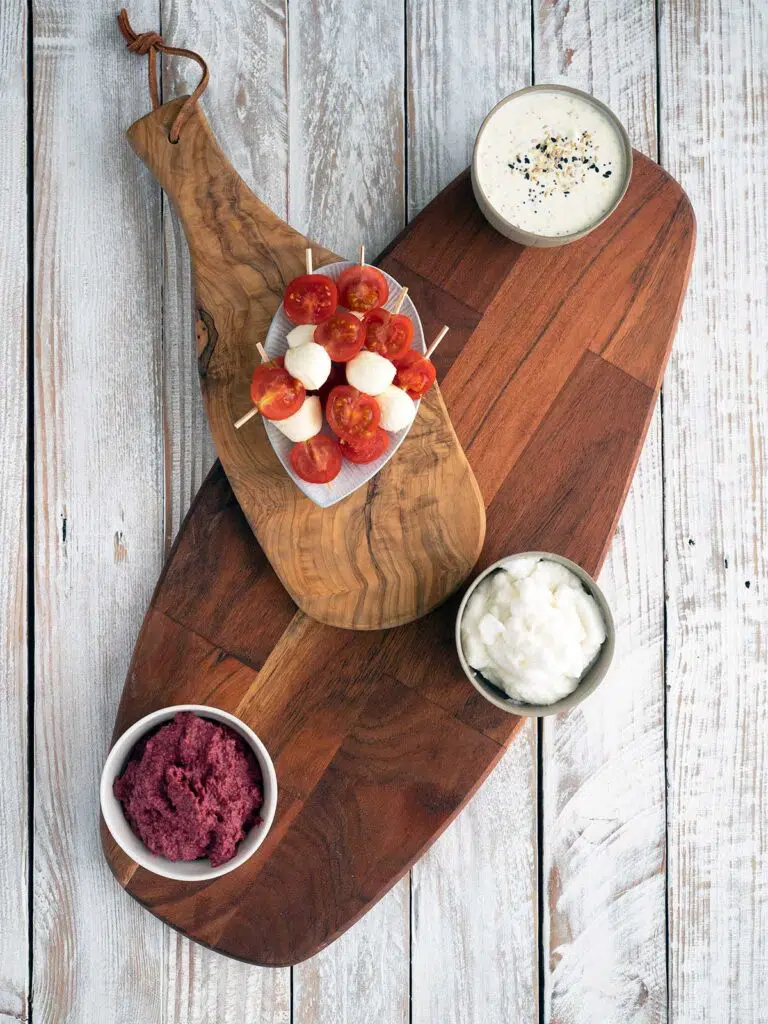
Step 3
Add any other bowls or plates to the board. I have placed the cherry tomato bocconcini skewers piled high on a small plate. You may have bowls of olives, crackers, or cheese.
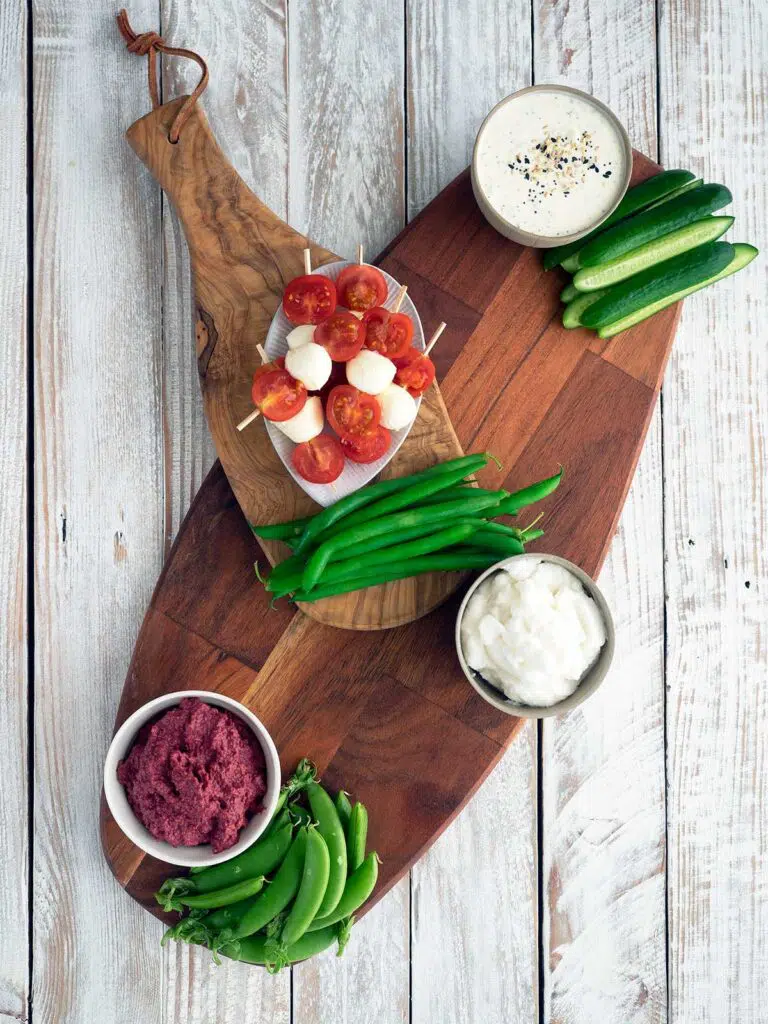
Step 4
Add your green vegetables. This will probably be the most prominent vegetable colour in your selection. By adding them to the board first you are distancing them from each other so they don't become a giant green mass.

Step 5
Add the rest of the vegetables between the green ones. Split up any vegetables that you feel are visually interesting, or a different shape, as I have done with the radishes.
Allow long vegetables to hang over the edges of the board slightly. In the end, it makes the board look like it is generously groaning with produce.

Step 6
Then add a variety of crackers and breadsticks. Choose a variety of colours, textures, and flavours.
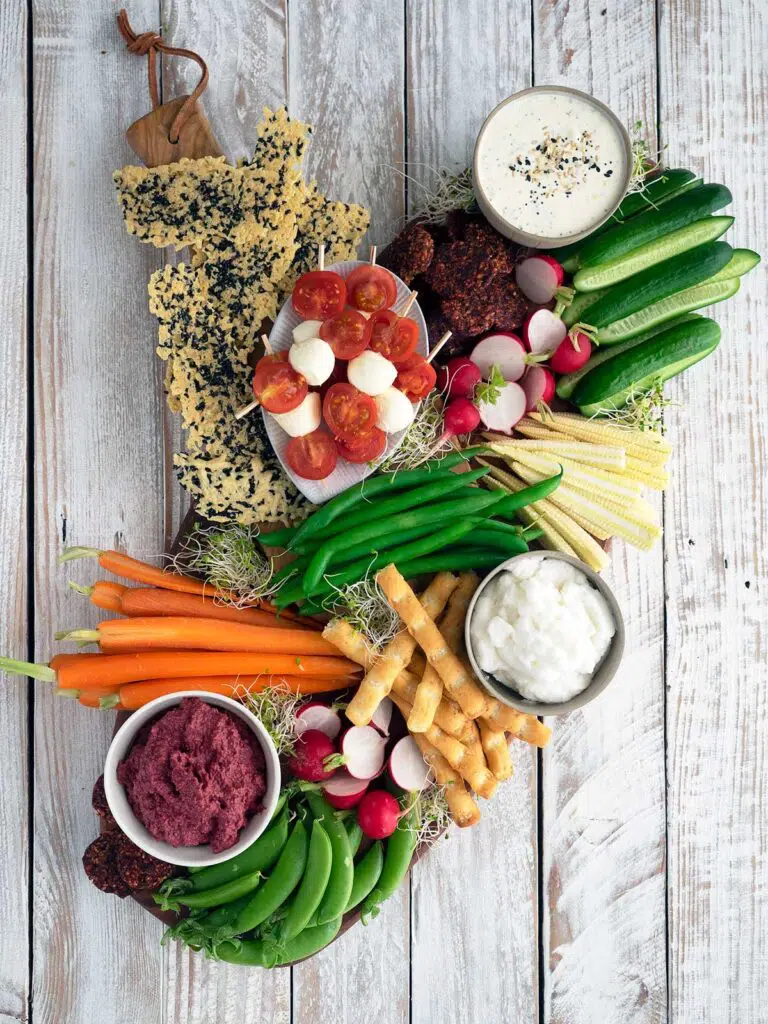
Step 7
Lastly, fill any empty spaces on the board with garnish. Above I have used alfalfa sprouts for interest. You can tuck in soft frilly lettuce leaves or herbs.
If using edible flowers, the time to add them is now. Use them to cover up the gaps.
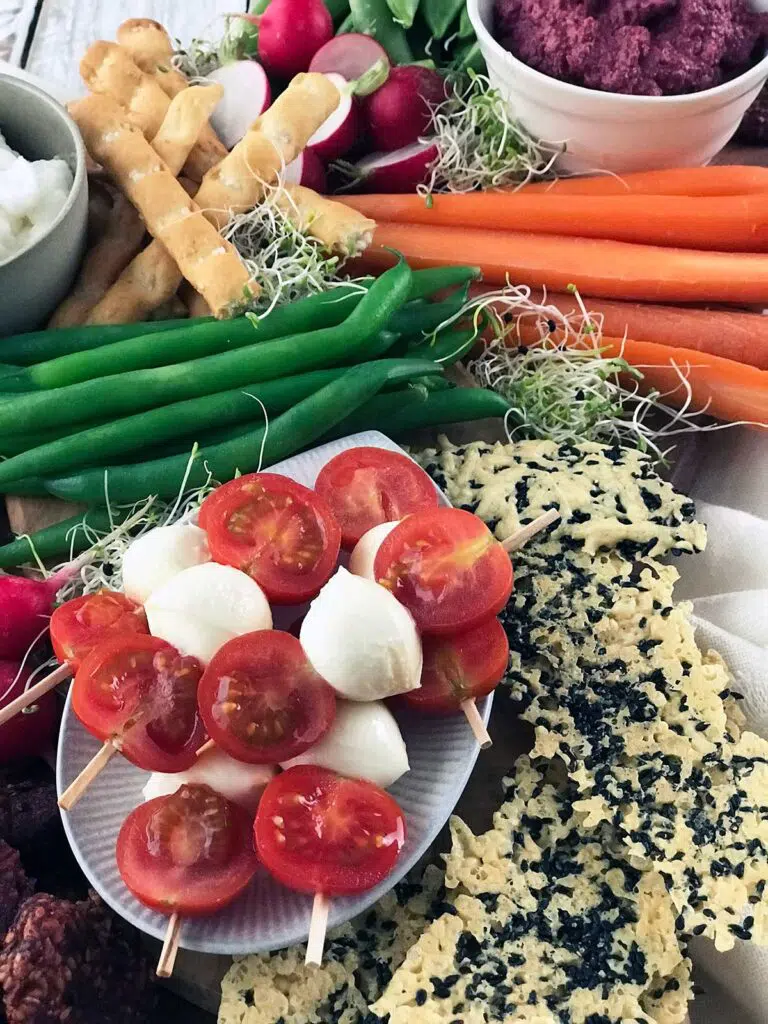
Crudité FAQs and Tips
My most important tip is to keep everything as cold as possible before serving.
If it is a particularly hot day you may want to nest individual bowls of dip into a larger bowl that contains ice. That way they will keep chilled while on the platter.
Have a large bowl filled with ice and water at the ready.
Bring a large pot of water to a boil. Add washed and trimmed vegetables to the boiling water.
Cook the vegetables for 1 to 5 minutes. They are done as soon as the colour of the vegetable turns bright and vibrant.
As soon as the vegetables are done, drain and plunge them into the bowl of ice and water. Leave them in the bowl until cold.
Drain vegetables in a colander and then dry with paper towel.
Green beans will take 2-3 minutes, Asparagus 2-4 depending on how thick the spears are.
Crudité is a French word meaning rawness and is pronounced kroo-dee-teh.
Wrap washed and peeled vegetables in damp paper towels and place them in an airtight container. Keep the container in the fridge until needed.
Printable Recipe

Crudité Platter
Ingredients
- 100 grams green beans | tops (stalks) removed and beans blanched
- 1 bunch Dutch carrots (baby carrots) | washed, or washed and peeled
- 1 punnet baby cucumbers | washed and cut in halves or quarters
- 1 punnet baby corn | washed and cornsilk removed
- 100 grams sugar snap peas | washed and strings removed
- 1 bunch radish | washed, larger ones cut in half, keep smaller ones whole
- 1 tub cherry bocconcini | drained and dried with paper towel
- various dips and crackers
- garnish such as alfalfa, various herbs, soft lettuce, or edible flowers
Instructions
Preparing the Crudité Elements
- Tomato and bocconcini skewers: Cut cherry tomatoes in half, thread one half onto a small skewer or toothpick, followed by a small bocconcini ball, then the other half of the tomato.
- Vegetables: Prepare all other vegetables as instructed above. Keep fresh in the fridge until ready to assemble the platter. Wrap them in some damp kitchen towel and place them in an airtight container.
- Dips & Dressings: If you are making homemade dips and dressings. Make them and store them in the fridge until needed.
Assembling the Crudité Platter
- Choose your serving platter or boards. Plus any bowls and plates you will be using on the platter.
- Arrange your platter or boards. Place any bowls of dip or dressing on the board. Space them out, and visually go for an odd number. You can always have more bowls of dip to the side of the main platter.
- Add any other bowls or plates to the board. I have placed the cherry tomato bocconcini skewers piled high on a small plate. You may have bowls of olives, crackers, or cheese.
- Add your green vegetables. This will probably be the most dominant vegetable colour in your selection. By adding them to the board first you are distancing them from each other so they don't become a giant green mass.
- Add the rest of the vegetables between the green ones. Split up any vegetables that you feel are visually interesting, or a different shape.It will create pops of colour between the green.
- Fill in the empty spaces with crackers and breadsticks. Choose a variety of colours, textures, and flavours.
- Lastly, fill any empty spaces on the board with garnish. Above I have used alfalfa sprouts for interest. You can tuck in soft frilly lettuce leaves or herbs.If using edible flowers, the time to add them is now. Use them to cover up the gaps.
Oven Temperatures
All oven temperatures are fan forced.
Measurement Notes
All measurements are Australian metric standard. All measures are level, and cups are lightly packed unless specified. 1 teaspoon = 5ml / 1 tablespoon = 20mls / 1 cup = 250ml /4 teaspoons = 1 tablespoon.
Recipe Notes
- Have a large bowl filled with ice and water at the ready.
- Bring a large pot of water to a boil. Add washed and trimmed vegetables to the boiling water.
- Cook the vegetables for 1 to 5 minutes. They are done as soon as the colour of the vegetable turns bright and vibrant.
- As soon as the vegetables are done, drain and plunge them into the bowl of ice and water. Leave them in the bowl until cold.
- Drain vegetables in a colander and then dry with paper towel.
- 1 teaspoon equals 5ml
- 1 tablespoon equals 20 ml (Nth America, NZ & UK use 15ml tablespoons)
- 1 cup equals 250ml (Nth America use 237ml)
- 4 teaspoons equal 1 tablespoon
- I use the below unless specified in my recipes.
NUTRITIONAL INFORMATION
The recipe's nutritional information is an approximation based on an online calculator. It is meant solely for reference purposes. If you're looking for precise details, be sure to double-check with your own research.


Queenie
All you suggestions are so helpful, thank you. Will be making a platter on the weekend and following you tips.
Grace
No more boring veg platters for me. Thank you for your styling tips, it all looks stunning.